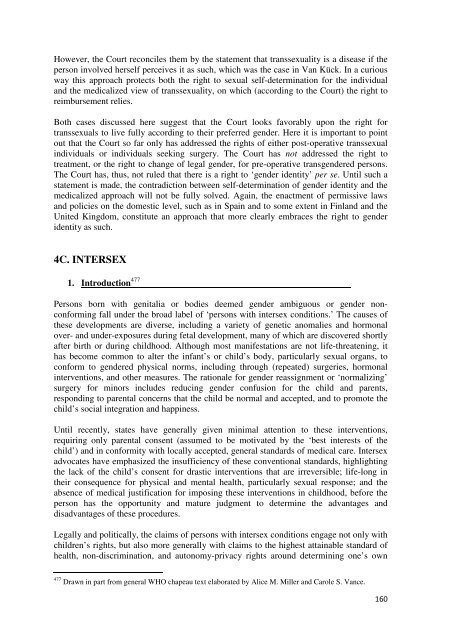Johanna Westeson - The ICHRP
Johanna Westeson - The ICHRP
Johanna Westeson - The ICHRP
Create successful ePaper yourself
Turn your PDF publications into a flip-book with our unique Google optimized e-Paper software.
However, the Court reconciles them by the statement that transsexuality is a disease if the<br />
person involved herself perceives it as such, which was the case in Van Kück. In a curious<br />
way this approach protects both the right to sexual self-determination for the individual<br />
and the medicalized view of transsexuality, on which (according to the Court) the right to<br />
reimbursement relies.<br />
Both cases discussed here suggest that the Court looks favorably upon the right for<br />
transsexuals to live fully according to their preferred gender. Here it is important to point<br />
out that the Court so far only has addressed the rights of either post-operative transsexual<br />
individuals or individuals seeking surgery. <strong>The</strong> Court has not addressed the right to<br />
treatment, or the right to change of legal gender, for pre-operative transgendered persons.<br />
<strong>The</strong> Court has, thus, not ruled that there is a right to ‘gender identity’ per se. Until such a<br />
statement is made, the contradiction between self-determination of gender identity and the<br />
medicalized approach will not be fully solved. Again, the enactment of permissive laws<br />
and policies on the domestic level, such as in Spain and to some extent in Finland and the<br />
United Kingdom, constitute an approach that more clearly embraces the right to gender<br />
identity as such.<br />
4C. INTERSEX<br />
1. Introduction 477<br />
Persons born with genitalia or bodies deemed gender ambiguous or gender nonconforming<br />
fall under the broad label of ‘persons with intersex conditions.’ <strong>The</strong> causes of<br />
these developments are diverse, including a variety of genetic anomalies and hormonal<br />
over- and under-exposures during fetal development, many of which are discovered shortly<br />
after birth or during childhood. Although most manifestations are not life-threatening, it<br />
has become common to alter the infant’s or child’s body, particularly sexual organs, to<br />
conform to gendered physical norms, including through (repeated) surgeries, hormonal<br />
interventions, and other measures. <strong>The</strong> rationale for gender reassignment or ‘normalizing’<br />
surgery for minors includes reducing gender confusion for the child and parents,<br />
responding to parental concerns that the child be normal and accepted, and to promote the<br />
child’s social integration and happiness.<br />
Until recently, states have generally given minimal attention to these interventions,<br />
requiring only parental consent (assumed to be motivated by the ‘best interests of the<br />
child’) and in conformity with locally accepted, general standards of medical care. Intersex<br />
advocates have emphasized the insufficiency of these conventional standards, highlighting<br />
the lack of the child’s consent for drastic interventions that are irreversible; life-long in<br />
their consequence for physical and mental health, particularly sexual response; and the<br />
absence of medical justification for imposing these interventions in childhood, before the<br />
person has the opportunity and mature judgment to determine the advantages and<br />
disadvantages of these procedures.<br />
Legally and politically, the claims of persons with intersex conditions engage not only with<br />
children’s rights, but also more generally with claims to the highest attainable standard of<br />
health, non-discrimination, and autonomy-privacy rights around determining one’s own<br />
477 Drawn in part from general WHO chapeau text elaborated by Alice M. Miller and Carole S. Vance.<br />
160
















